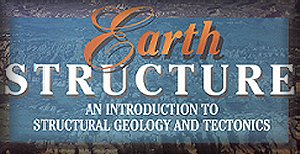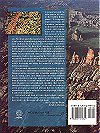
|
Preface
(with authors' info) 
Publisher's Info (McGraw-Hill) International sales (McGraw-Hill) Contents Corrections Contact Info Top Ten Supplements (websites and activities in Structure/Tectonics) Click here to enter the GuestBook |
| Section
A. Fundamentals
Chapter 1. Introduction Chapter 2. Primary and Nontectonic Structures Chapter 3. Force and Stress Chapter 4. Deformation and Strain Chapter 5. Rheology Section B. Brittle Structures Chapter 6. Brittle Deformation Processes Chapter 7. Joints and Veins Chapter 8. Faults and Faulting Section C. Ductile Structures
Appendix
|
Section D. Tectonics and Regional
Deformation
Chapter 14. Whole Earth Structure and Plate Tectonics Chapter 15. Extensional Tectonics Chapter 16. Convergence and Collision Chapter 17. Fold-Thrust Belts - Essay (with Scott Wilkerson) Chapter 18. Strike-Slip Tectonics
|
Don't speak (like) English?
Need a (crudely) translated version of this page or any other text? Go to Babelfish
Ayez besoin de la version traduite de a (crûment) de cette page ou de n'importe quel autre texte? Allez à Babelfish
Benötigen Sie übersetzte Version a (grob) dieser Seite oder jedes möglichen anderen Textes? Gehen Sie zu Babelfish
Necessite a versão traduzida de a (crua) desta página ou de todo o outro texto? Vá ao local de Babelfish
Heb je een grofweg vertaalde pagina nodig? Dan vind je dat niet bij Babelfish
Necesite la versión traducida de a (crudo) de esta paginación o de cualquier otro texto? Vaya a Babelfish
Avere bisogno della versione tradotta di a (crudamente) di questa pagina o di qualunque altro testo? Andare al luogo di Babelfish
Software
Stereonet for Mac, by Rick Allmendinger. A program for spherical projection of directional datasets. Go to the original source at ftp://www.geo.cornell.edu/pub/rwa/Stereonet/ where you will find the latest version of the program and other information.
StressMohr
for Windows, by Ulrich Kruse. This program illustrates the use
of stress calculations for two-dimensional systems. The program consists
of five displays. In each display you can vary the physical situation and
immediately see the effects in the graphical displays. The first display
illustrates the relation between forces and stresses acting on a rectangular
solid. In the second display, you explore the stress on a plane as you
vary the orientation of the plane and the state of stress in the system.
We illustrate the calculation of the stress on the plane in terms of a
simple matrix multiplication in the third display. You can also observe
the simple geometry of the envelope of the stresses that are produced as
the angle of the plane is varied. The fourth display shows the behavior
of the normal and shear components of the stress on the plane. When the
normal component is plotted along x and the shear component along y, the
envelope will be a circle: called a Mohr circle. This beautiful result
lets you visualize the range of possible stresses on the plane. Finally
in the last display, you can explore the conditions which lead to the fracture
of a sample: you can vary the stresses until the stresses are just strong
enough to cause fracture by watching the changes in size and location of
the Mohr circle.
Click here
to download the zipfile that contains the program and a MSWord version
of the manual. The manual is also available online by clicking
here.
Strain Calculator (0<Wk<1) for W95, by Rod Holcombe. Strain Calculator presents strain data and calculations graphically and numerically. Conversions of strain ratios to stretches at a given volume change can be plotted directly onto a logarithmic strain plot (see screen shot). Shear zone parameters (ellipticity, deformed and undeformed orientations, etc.) for any shear strain value or vorticity number (Wk) are calculated and shown graphically. Please note use restrictions.
Strain
- Coaxial strain - lines (Rod Holcombe)
- Coaxial strain - particle paths (Rod Holcombe)
- Non-coaxial strain - lines (Rod Holcombe)
- Non-coaxial strain - random ellipses (Rod Holcombe)
- Antitaxial vein and Syntaxial vein (Paul Bons and Mark Jessell)
- Edge, Screw and Mixed dislocation glide (John Russ)
- Burgers vector in Edge dislocation and Screw dislocation (John Russ)
- Fabric development (simulated) in quartz at low Th, representative of a single glide system,
- Fracture and frictional flow in OCP (Win Means)
- Porphyroclasts (Coen ten Brink)
- Recrystallization-static in OCP (Win Means)
- Recrystallization-dynamic in OCP (Win Means)
- Stylolites (Mark Jessell and Paul Bons)
- Fault-bend fold (Rick Allmendinger)
- Duplex (Rick Allmendinger)
- Planes and Lines in stereographic projection (John Waldron)
- Plate motion since 750 Ma (Berkeley Museum of Paleontology using Chris Scotese's maps)
- Image Gallery (photos of geologic features and concepts; University of British Columbia)
- Interactive Geologic Time Scale (Berkeley Museum of Paleontology)
- Deformation Microstructures (Jessell/Bons/Rey at Monash University)
- Deformation microstructures of rocks (Tullis/Teyssier/Stünitz at Minnesota); small images and descriptions of microstructures in experimentally deformed rocks.
- Microstructures of (deformed) metamorphic rocks (Allen Glazner at UNC)
- Atlas of Structural Geophysics (Mark Jessell at Monash University); examples of the relationship between three-dimensional structure and potential-field response.
- Periodic table of the elements
- Table of the Nuclides
- Visualizations in Materials Science (ViMS by John Russ)
- Visualizing Stress and Strain (Reish and Girty at SDSU); also downloadable versions.
- Cajon Pass (Joshua Meyers)
- Grand Canyon (QTVR image; Digital West)
- Grand Teton (Winona State University)
- Hayward Fault, California (Sue Ellen Hirschfeld)
- Hartford (Triassic) Rift Basin, Connecticut (Colby College)
- Harz Mountains, Germany (in German)
- Moine Thrust, Caledonides of NW Scotland (Rob Butler)
- Nanga Parbat, W Himalayas (Rob Butler)
- Oman Ophiolite (Paul Browning)
- French Alps/Helvetides (Rob Butler)
- San Andreas Fault, California (Joe Dellinger)
- Tetons National park, Wyoming
- Things to see as a geologist (Terry Acomb)
-
 WebElements
links to Geological information
WebElements
links to Geological information - Vitual Geoscience Library
- Igneous, Sedimentary & Metamorphic Rock Info
- JOBS.....in Structural Geology & Tectonics
- Image Gallery - images of geologic features and concepts
- Minerals by Name
- National Geophysical Data Center (NOAA)
- Structural Geology and Tectonics Division (GSA) - S/T info and link to sites
- Structural geology on the Web
- Structural geology courses on the Web
- American Association of Petroleum Geologists (Geobyte)
- American Geological Institute
- American Geophysical Union and Tectonophysics Section
- American Rock Mechanics Association (RockNet)
- Australian Geodynamics Cooperative Research Center
- Canadian Society of Petroleum Geologists
- Canadian Tectonics Group
- Geological Association of Canada
- Geological Survey of Canada
- Geological Society of America
- International Association of Structural/Tectonic Geologists
- National Science Foundation
- Seismological Society of America
- Tectonic Studies Group (UK)
- United States Geological Survey
- Yahoo's Geology and Geophysics directory
- Ben van der Pluijm's homepage
- Steve Marshak's homepage
- email Ben for comments, questions and suggestions (use local email program or remote web-based form)
Microstructures
and medium Th, representative of multiple glide systems (Mark Jessell and Paul Bons)
Thrust Structures
Projections
Plate tectonics
Other Links
Disclaimer. The text and illustrations on this and linked EarthStructure pages are strictly for educational purposes. All opinions expressed are the responsibility of the authors and do not represent those of publisher nor the home institutions of the authors.
Copyright. This page and its links contain copyrighted material. Reproduction in any form requires permission from the original copyright holders, the authors and/or the publishers.
You are #